Architects & Firms
This article was originally published on October 20.
The architectural assortment at Brown University, in Providence spans Georgian, Richardsonian, Neoclassical, pseudo-Federal, Brutalist, and everything in between. The latest addition to the College Hill campus’s eclectic mix is a nearly industrial-looking silvery aluminum-clad box—a mysterious volume that is mostly blind, except for a glazed ribbon that slices dynamically through its fluted facades near the ground.
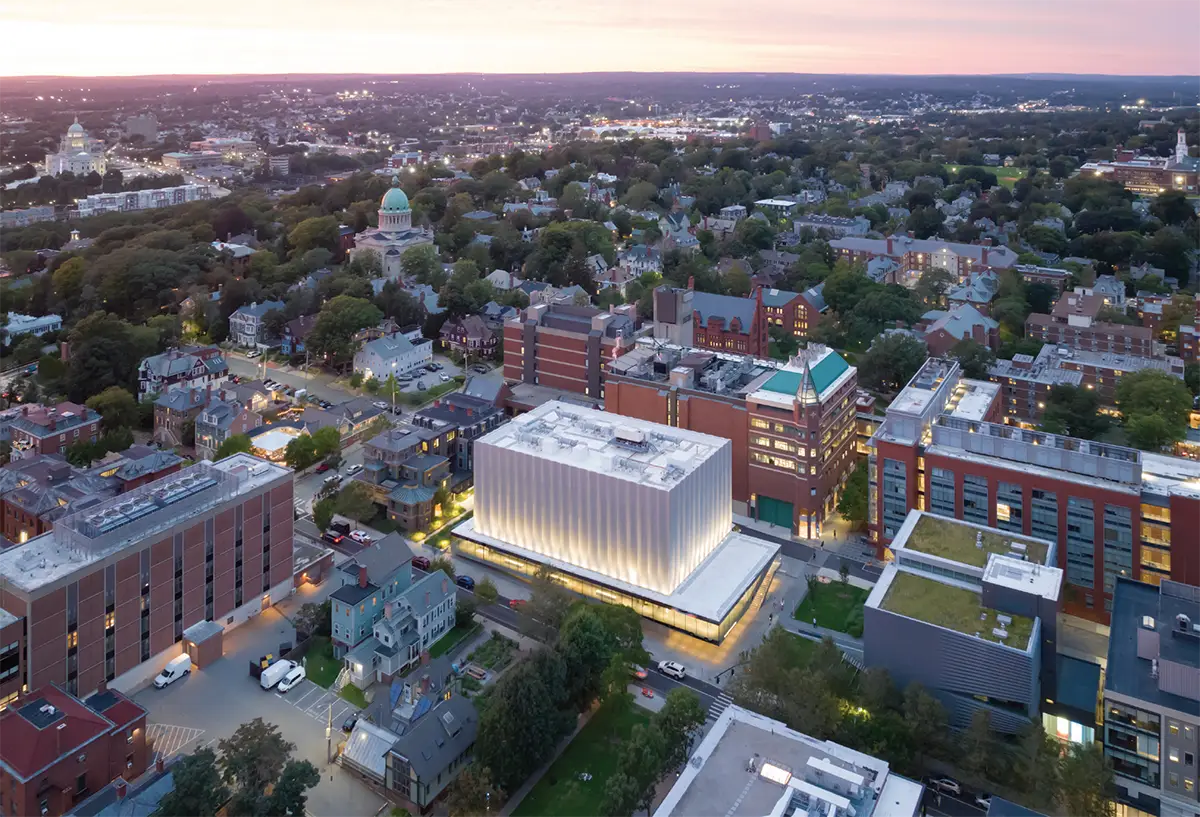
The volume enclosing Lindemann is clad in aluminum that is fluted, in part to disguise the joints between panels (above and top of page). Photo © Iwan Baan, click to enlarge.
The enigmatic 75-foot-tall volume is The Lindemann Performing Arts Center, designed by REX, the New York–based architecture firm founded by Joshua Ramus. On Angell Street—a main artery on the city’s East Side—the 101,000-square-foot building, striking in its simplicity, creates a scalloped profile against the sky, announcing the importance of the arts at Brown, which prides itself on its interdisciplinary approach to higher education. “The arts permeate all aspects of the curriculum,” explains Christina Paxson, the university’s president.
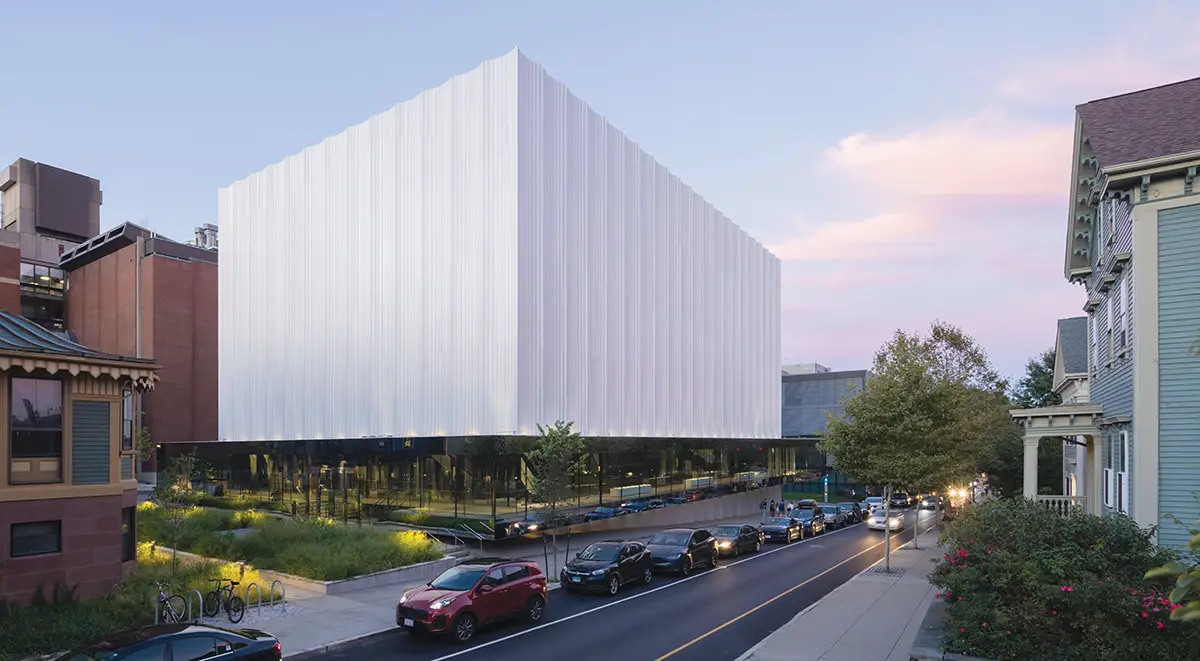
1
The building, sited on busy Angell Street (1), has a lobby that cantilevers over the entry stair and stadium seating (2). Photos © Iwan Baan
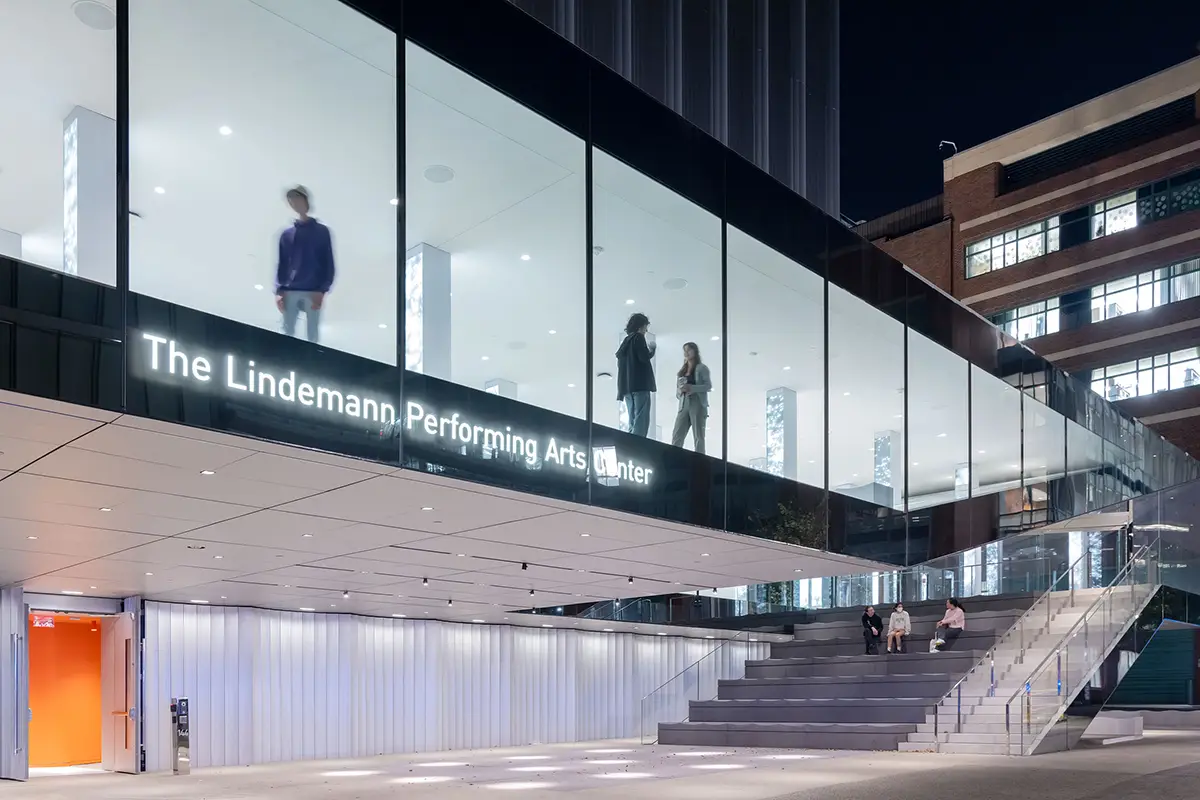
2
In conceiving Lindemann, Brown’s first priority was establishing a home for its orchestra, since the group had long been performing in Sayles Hall. The late 19th-century granite-and-brownstone edifice, centrally located on the main college green, contains one of the university’s largest assembly spaces, but has substandard acoustics. The programmatic requirements for the new building didn’t stop there. His brief, says Ramus, was a facility that could be intensively used, on a daily basis—by all the performing arts—rather than a space that would be mostly dark except for the orchestra’s few concerts each year.
The answer was a building that could serve as several venues in one. However, designing an exceptional multipurpose performance space can be tricky, points out Ramus: “The classic problem with them is that they are good for all but not great for anything.” At Brown, one of the many challenges was creating the reverberation times and ensemble conditions required by orchestral music, which are primarily dependent on a large interior volume, without sacrificing the intimacy desired for drama or dance.
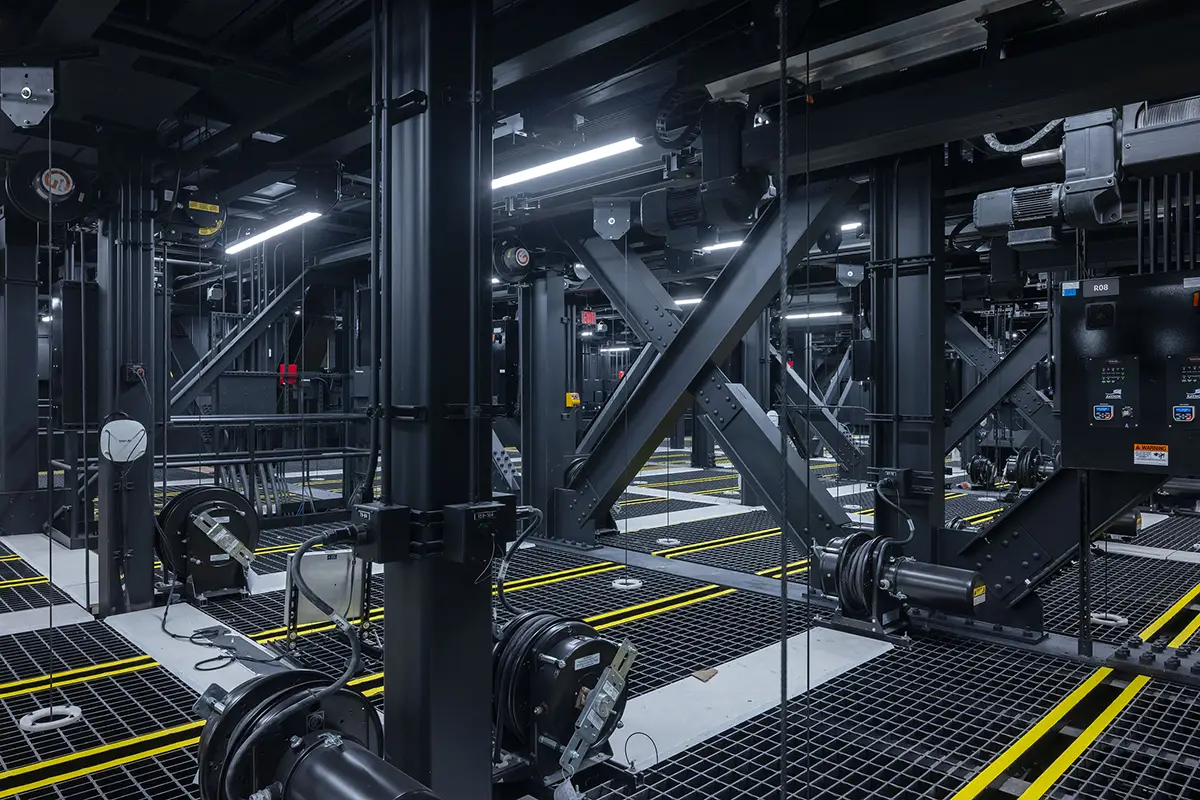
3
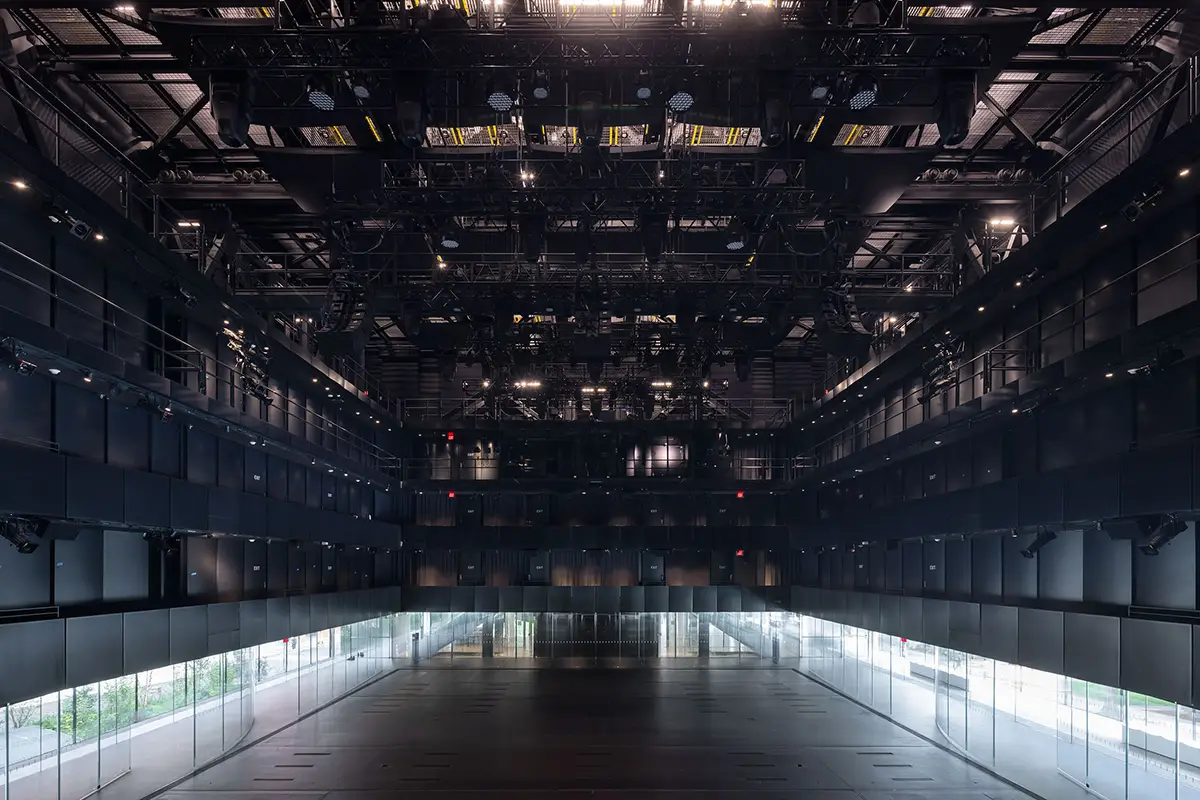
4
Bogies and winches (3), located below the roof, enable the transformation of the main hall (4). Photos © Iwan Baan
Click drawing to enlarge
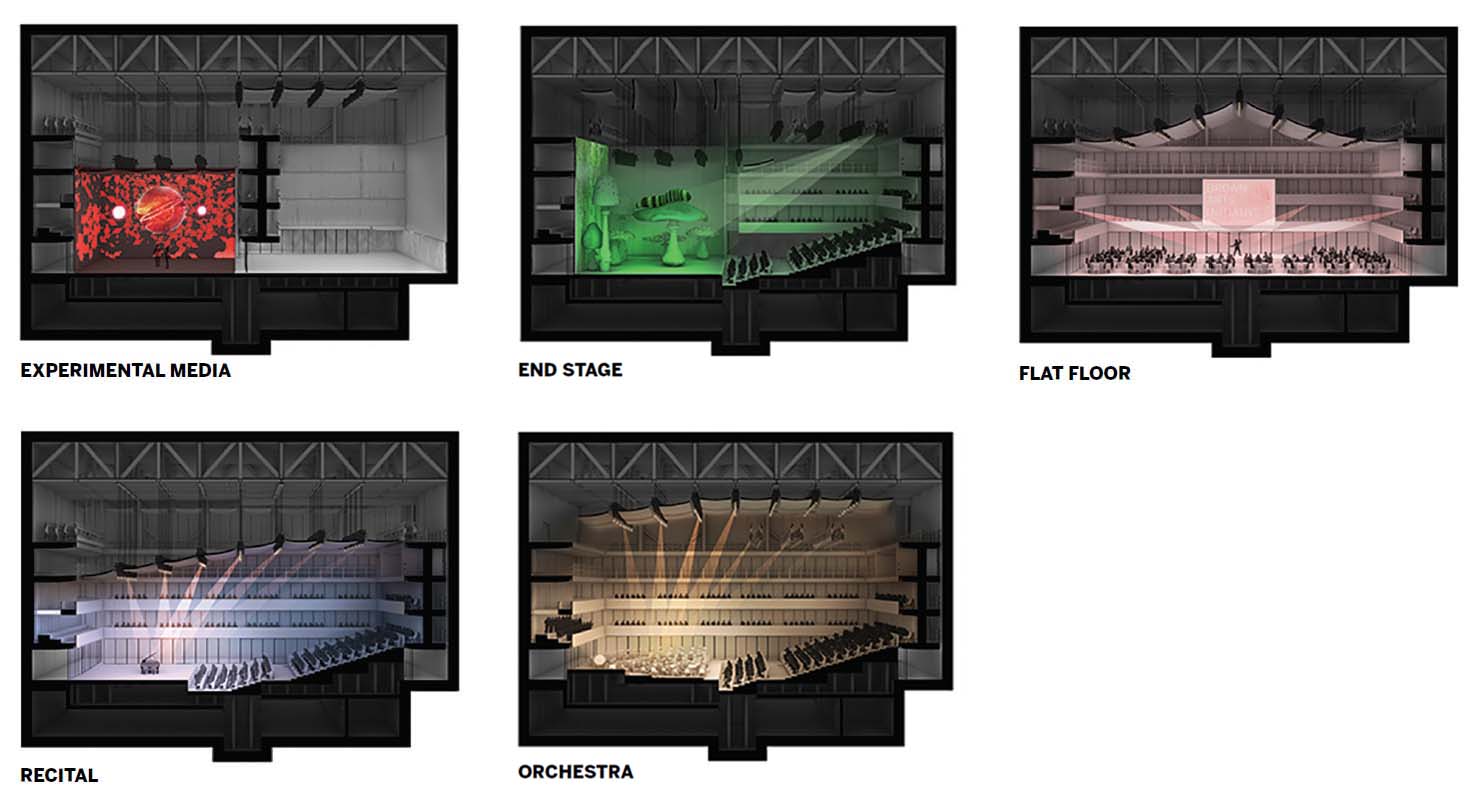
With these competing desires in mind, the architects designed a concert hall with a relatively tight footprint, about 59 by 88 feet, and for a correspondingly small audience of 530 people. They then established the needed acoustical volume by making it taller than they otherwise would have (nearly 67 feet from the theater floor to the underside of the roof structure). The resulting space accommodates a stage for Brown’s 100-piece orchestra, along with a loft for its 70-person choir. The shoebox-shaped room, rendered almost completely in an inky blue-black, is ringed by four suspended balconies (two for people and two for lighting and other equipment). In turn, suspended from those levels, just above the floor, are a series of curved glass acoustical reflectors whose purpose is to direct high-frequency sound back into the room.
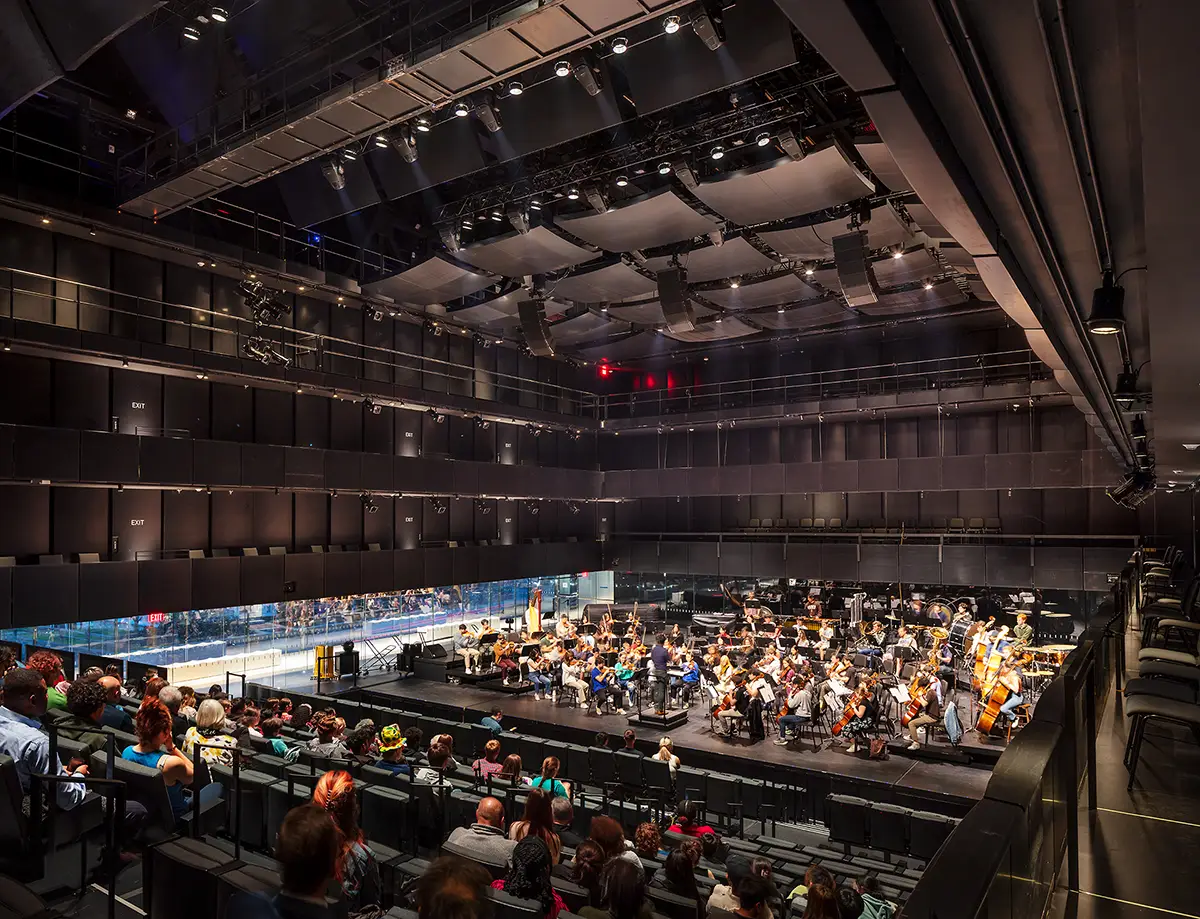
A performance underway in Lindemann’s main hall. Photo © Warren Jagger, courtesy Brown Arts Institute and Brown University
In addition to the concert-hall configuration, Lindemann can also be transformed into four other primary geometries: a large flat-floor room; a 388-seat recital hall; a 275-seat end-stage theater; and a “media cube” for immersive digital and video art. And because the building is intended as a teaching facility, it also has rehearsal spaces, for orchestra, theater, and dance, in two below-grade levels. Clad in perforated Douglas fir, equipped with sprung floors, and constructed as “box in box” rooms for acoustical isolation, all double as performance venues.
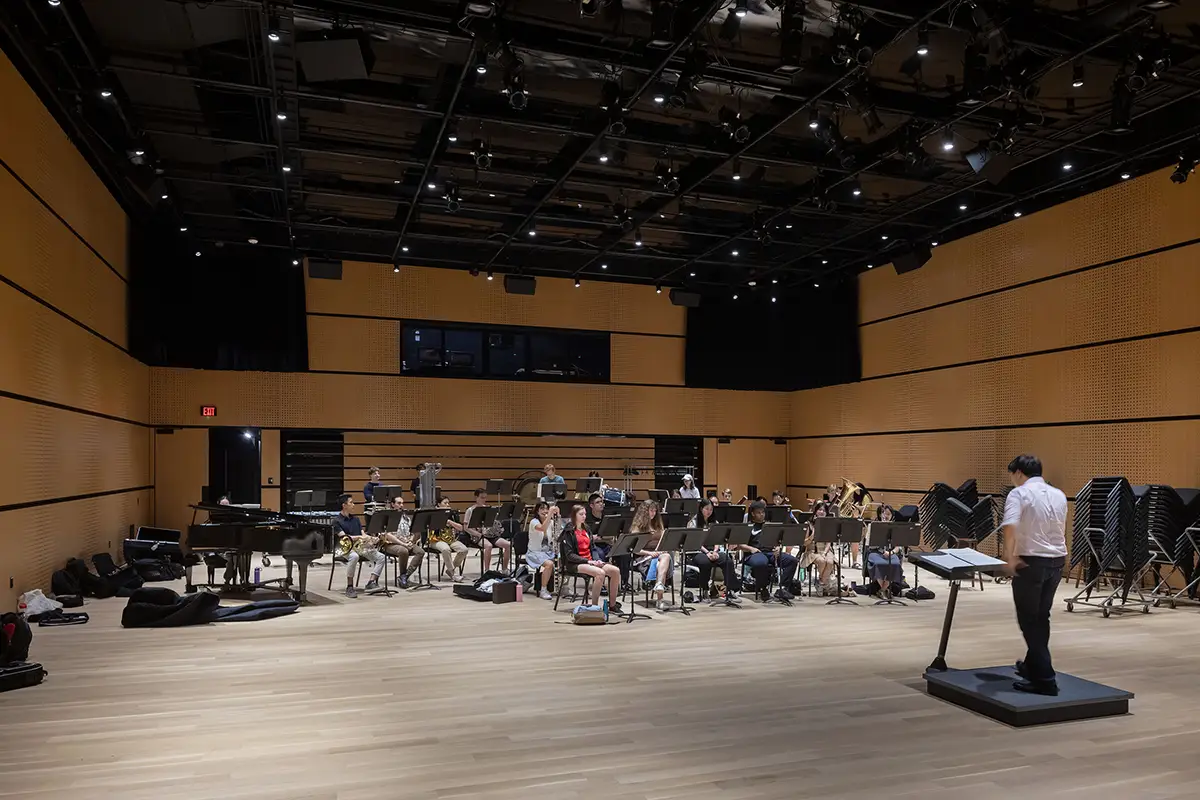
Basement-level rehearsal spaces double as performance venues. Photo © Iwan Baan
The main hall’s conversion from one use to another can be accomplished by eight people—including riggers and stagehands—in four to eight hours. The transformation is enabled by an array of automated and manually operated equipment, such as adjustable acoustic reflectors and curtains, lighting bridges, stage lifts, telescoping orchestra risers, and retractable seating. Even normally stationary building services, such as power, data, and water (for fire suppression) have been designed to be moved along with the other reconfigurable devices.
Lindemann is not Ramus’s first transformable performing arts building. The Dee and Charles Wyly Theatre, in Dallas, designed by him as partner in charge of the project at REX/OMA, and Rem Koolhaas, was completed in 2009. REX’s Perelman Performing Arts Center, opened in Lower Manhattan earlier this fall. Though contemporaneous with Perelman, Lindemann is more akin to the older project—at least in regard to its facade treatment. While Perelman is shrouded in Portuguese marble, Wyly has a glazed base that reveals what is happening inside. Lindemann takes a similar approach to transparency, but through an element that Ramus refers to as a “clerestory.” This glass-enclosed circulation space wraps the building on three sides at stage level. Depending on the time of day, interior configuration, and the lighting arrangement, the clerestory will showcase the activity within to passersby and the university community.
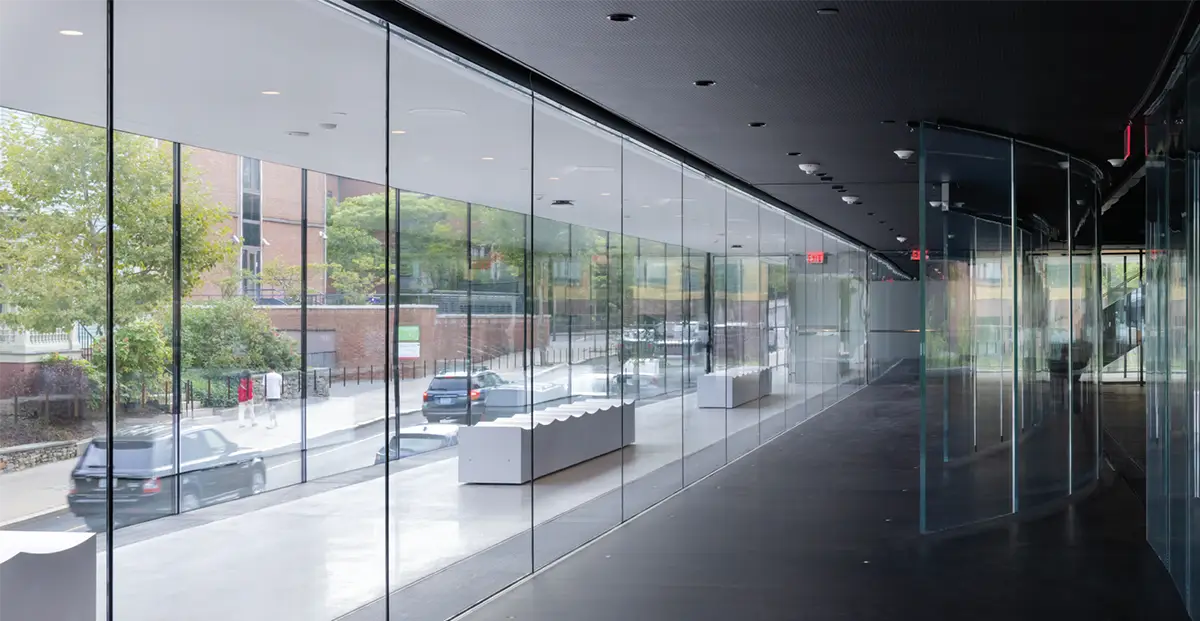
5
A glazed “clerestory” (5 & 6) wraps the building at stage level. Photos © Iwan Baan
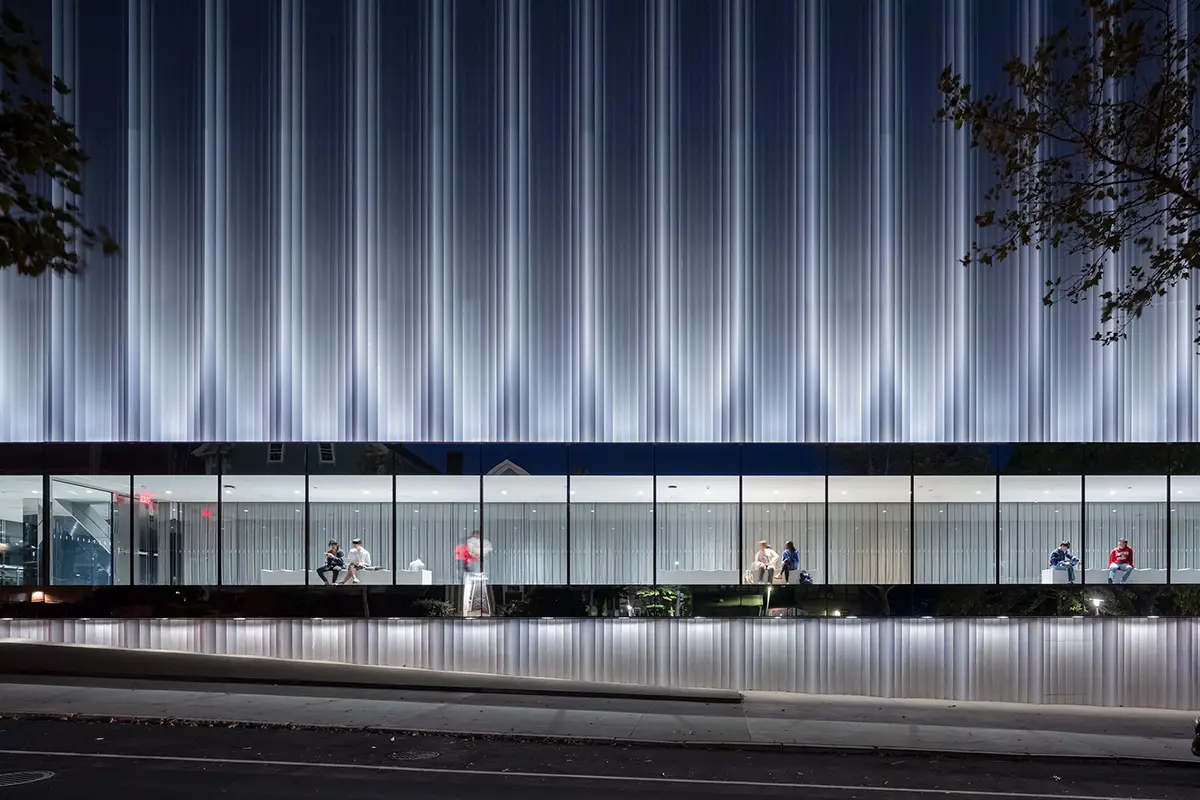
6
The necessarily column-free volume that houses the reconfigurable performance space is made possible by Lindemann’s fixed structure. Underneath the aluminum skin, which is fluted in part to help disguise the horizontal joints between panels, steel belt trusses extend the full height of the two long facades. They span more than 111 feet between steel-framed stair towers at each of the shorter ends. From the eastern tower, the clerestory extends to form the lobby—a floating glass box that cantilevers 37 feet, making Lindemann appear to be reaching out gregariously, across a campus pedestrian way, toward its neighboring arts facility, the Perry and Marty Granoff Center, a 2011 Diller Scofidio + Renfro project with studio, workshop, and lab space for the visual and performing arts.
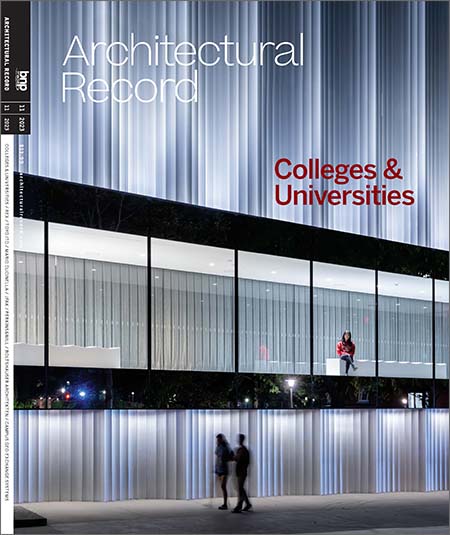
To enter Lindemann, performance-bound users walk through the sheltered outdoor area below its low-slung cantilever, which hovers just 10 feet above the ground—a route that, on a recent gray day, before the building had officially opened, seemed uninviting. However, Avery Willis Hoffman, the artistic director of the Brown Arts Institute, which manages the building, promises that the students will devise installations and events that will activate the compressed space. Toward that end, it has infrastructure to support a variety of activities, including lighting, as well as stepped seating whose horizontal surface has been cleverly sculpted to incorporate the facade’s fluted profile.
If visitors may find the entry path less than alluring, they will be rewarded once they ascend the gently sloped flight of stairs to the lobby. The room is only 8 feet 9 inches high and filled with what appears to be a field of 30 closely spaced columns. Instead, they are the vertical elements of a two-way Vierendeel truss supporting the cantilever. But, despite its modest scale and the number of structural components, the space feels expansive, due to its floor-to-ceiling glazing, reflective polished concrete floor, and, in no small part, to a site-specific installation by digital artist Leo Villareal. The piece, called Infinite Composition, consists of LED panels mounted on the column-like struts, displaying flowing and shifting light patterns that serve to dematerialize them.
The shifting, non-repeating nature of Villareal’s piece provides a fitting foreshadowing for the mutable performance space beyond, and the creative magic to take place within.
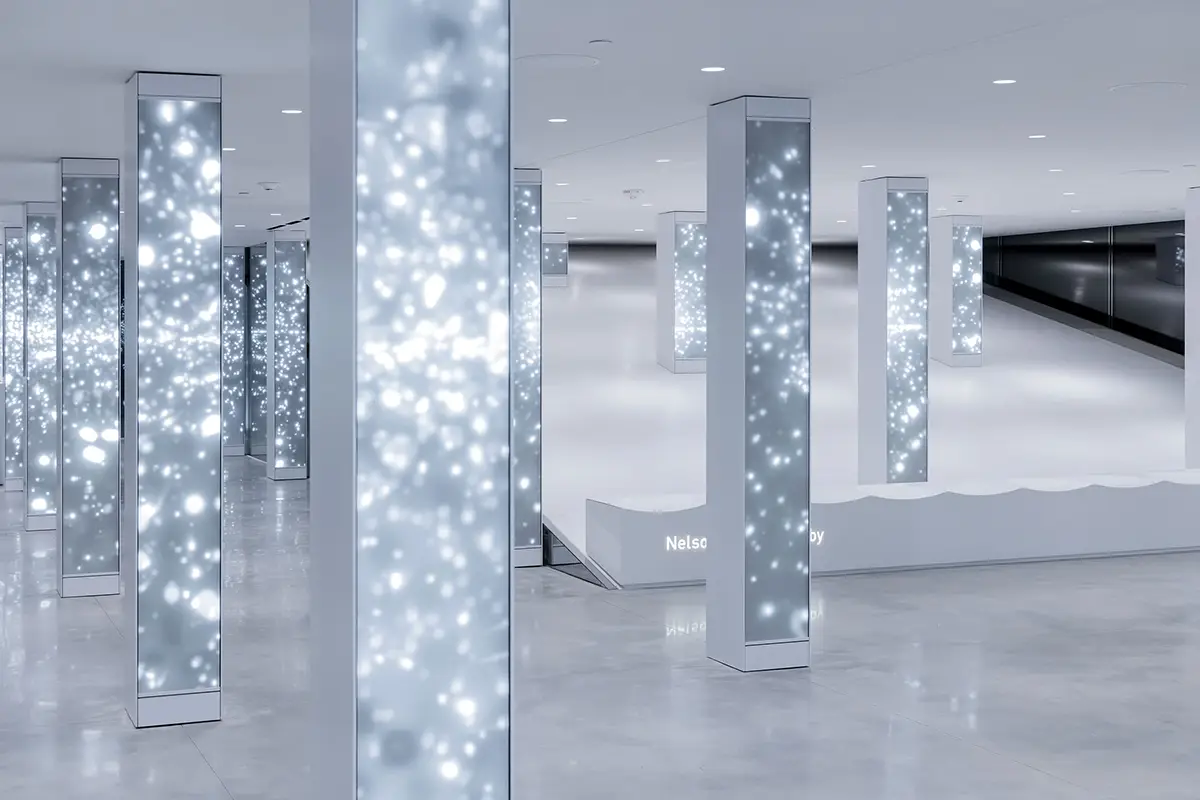
An installation by Leo Villareal is mounted on structural elements in the lobby. Photo © Iwan Baan
Main theater timelapse. Courtesy Brown Arts Institute
Click plans to enlarge
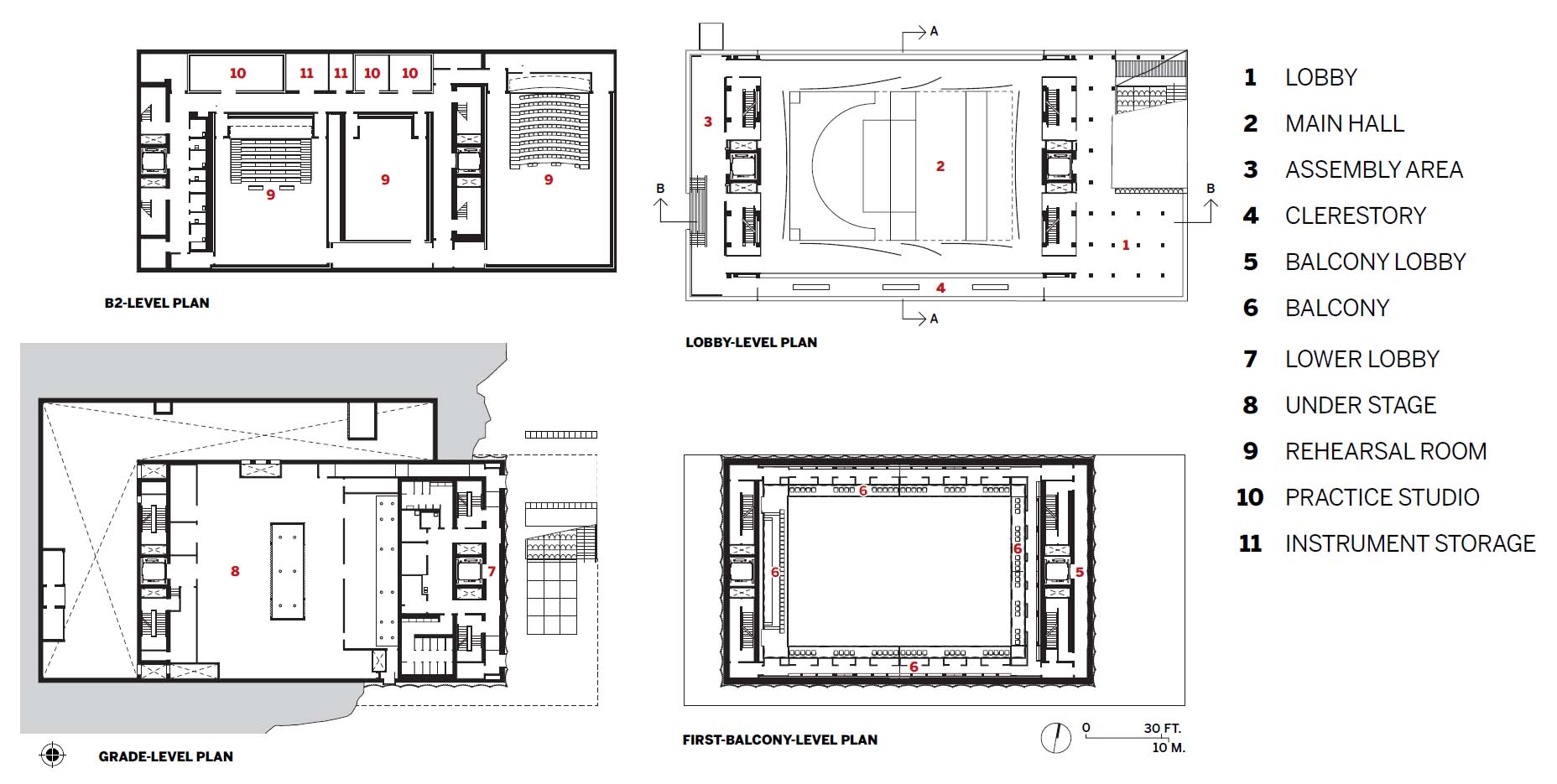
Click sections to enlarge

Click drawing to enlarge
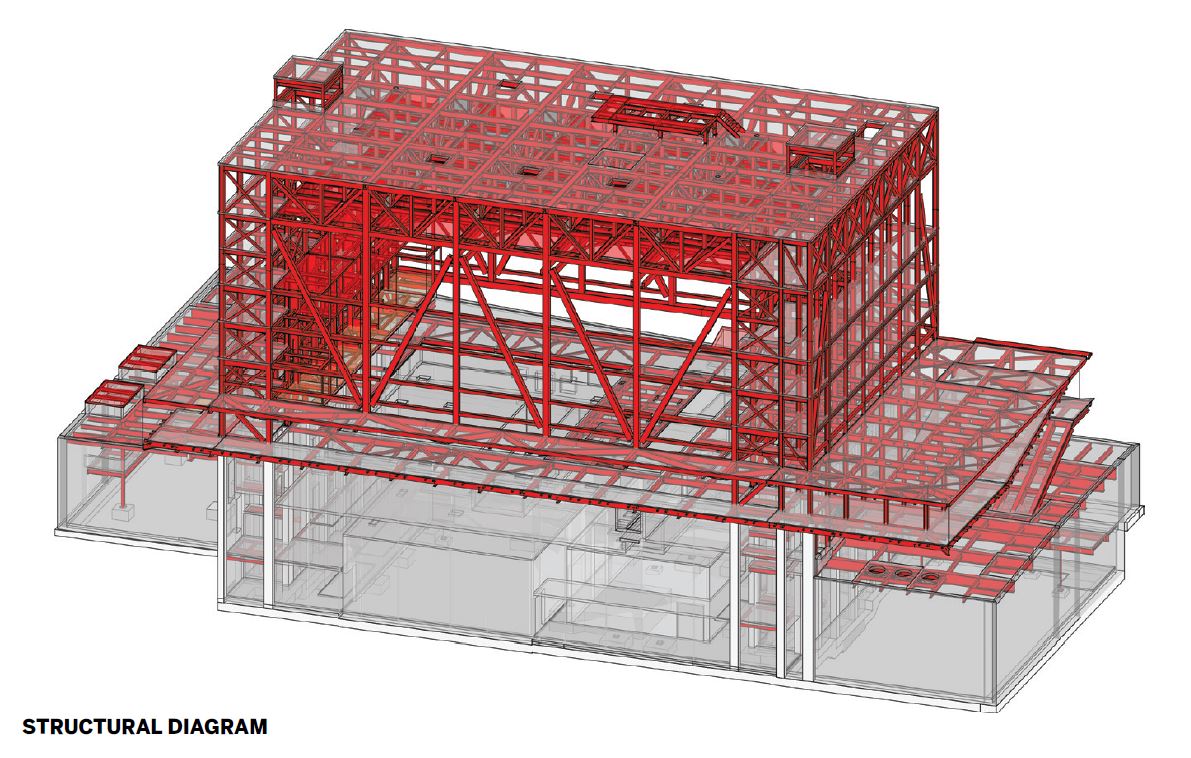
Credits
Architect:
REX — Joshua Ramus, principal in charge; Adam Chizmar, project leader; Maur Dessauvage, Sebastian Hofmeister, Kevin Thomas, Kelvin Ho, Nicolas Lee, Tim Carey, Davis Richardson, project team
Consultants:
Odeh (structural engineer of record); Magnusson Klemencic (consulting structural engineer); Arup (m/e/p); Atelier Ten (sustainability); Front (facades); Theatre Projects (theater design/stage equipment); Threshold Acoustics (acoustical/AV); Acentech (acoustical sub-consultant); L’Observatoire International (lighting)
General Contractor:
Shawmut Design & Construction
Client:
Brown University
Size:
101,000 square feet
Cost:
Withheld
Completion Date:
September 2023
Sources
Aluminum Rainscreen:
Roschmann Group
Interior Glazing:
Vitro, Safti First, AGC Interpane
Metal Doors:
Assa Abloy
Main Hall Sound Reflector Panels:
Glenn Rieder
Acoustic Isolation Pads:
Kinetics
Lighting:
Reflex Lighting, Lucifer Lighting, USAI, B-K Lighting, XAL USA, BEGA, PureEdge Lighting, Ecosense Lighting
High-Impact Wallboard:
National Gypsum




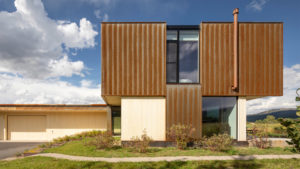
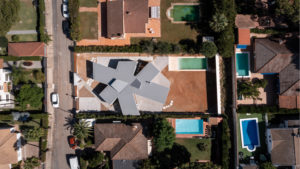
.jpg?height=300&t=1713468361&width=300)
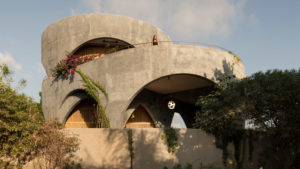
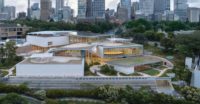

Post a comment to this article
Report Abusive Comment